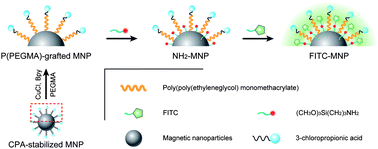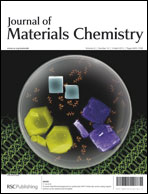Water-soluble poly(poly(ethyleneglycol)monomethacrylate)-grafted (P(PEGMA)-grafted) Fe3O4 nanoparticles synthesized via a solvent-free atom transfer radical polymerization (ATRP) method were conveniently surface-modified with 3-aminopropyltrimethoxysilane as anchor molecules to donate NH2 groups. Fluorescent magnetic nanoparticles (MNPs) were then obtained by covalently bonding fluorescein isothiocyanate (FITC) to the NH2 groups. The successful modification of the MNP surface was ascertained from FT-IR and XPS analyses, indicating that such a facile post-ATRP modification approach for introducing NH2 groups will extend the potential applications of polymer-coated MNPs produced via the ATRP method. The as-synthesized FITC-grafted MNPs (FITC-MNPs) showed good water solubility and stability, and have a uniform hydrodynamic particle size of 36.2 ± 2.2 nm. These nanoparticles are superparamagnetic with a saturation magnetization (Ms) of 23 emu g−1, which is sufficient for bioapplications. The uptake of the fluorescent MNPs by macrophage cells is about 2 pg Fe/cell, which is nearly similar to the pristine P(PEGMA)-grafted MNPs with good biocompatibility. Furthermore, an MMT assay using the 3T3 fibroblasts indicates the low cytotoxic effect of the FITC-MNPs. The FITC-MNPs can be efficiently uptaken by breast cancer cells up to 85 pg Fe/cell, which might be due to the high solubility of the P(PEGMA) chains in the cell membranes. Confocal microscope results showed that the FITC-MNPs were located inside the breast cancer cells but not within the cell membranes. These results indicate that FITC-MNPs with both fluorescence and magnetic functionalities have great potential for applications in bioimaging.

You have access to this article
 Please wait while we load your content...
Something went wrong. Try again?
Please wait while we load your content...
Something went wrong. Try again?


 Please wait while we load your content...
Please wait while we load your content...